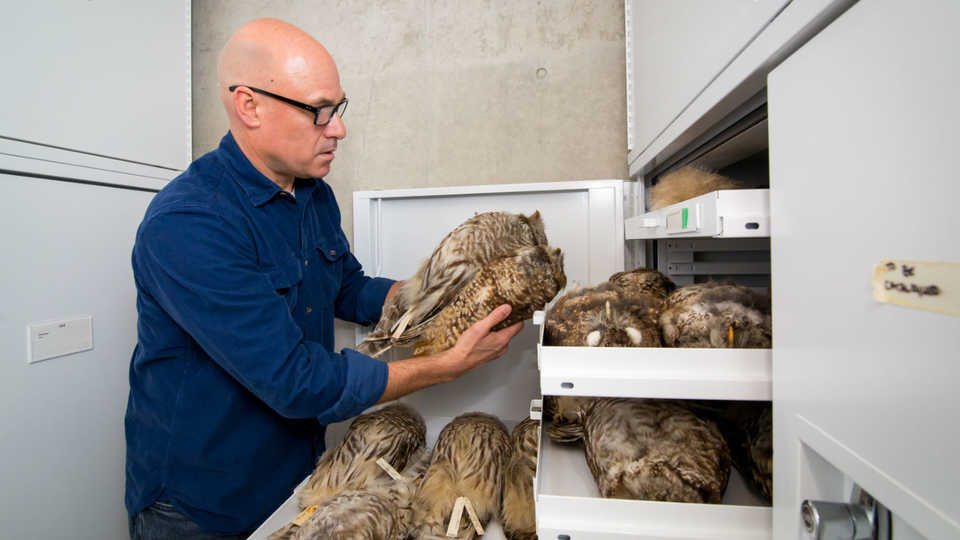The Institute for Biodiversity Science and Sustainability at the California Academy of Sciences is at the forefront of efforts to understand two of the most important topics of our time: the nature and sustainability of life on Earth. Based in San Francisco, the Institute is home to more than 100 world-class scientists, state-of-the-art facilities, and nearly 46 million scientific specimens from around the world. The Institute also leverages the expertise and efforts of more than 100 international Associates and 400 distinguished Fellows. Through expeditions around the globe, investigations in the lab, and analysis of vast biological datasets, the Institute’s scientists work to understand the evolution and interconnectedness of organisms and ecosystems, the threats they face around the world, and the most effective strategies for sustaining them into the future. Through innovative partnerships and public engagement initiatives, they also guide critical sustainability and conservation decisions worldwide, inspire and mentor the next generation of scientists, and foster responsible stewardship of our planet.
As timberland converts to cannabis, spotted and barred owls test positive for rat poison.
Wildlife species are being exposed to high levels of rat poison in northwest California, with illegal marijuana farms the most likely source point, according to a study led by the University of California, Davis, with Jack Dumbacher, Curator of Ornithology and Mammalogy at the California Academy of Sciences.
The study, released Jan. 11 in the journal Avian Conservation and Ecology, showed that seven of the 10 Northern spotted owls collected tested positive for rat poison, while 40 percent of 84 barred owls collected also tested positive for the poison.
The study is the first published account of anticoagulant rodenticide in Northern spotted owls, which are listed as a threatened species under federal and state Endangered Species acts.
The study area encompasses Humboldt, Mendocino, and Del Norte counties. It supports previous accounts that rat poison is contaminating the food web in this region, as the primary food source for owls–rodents—is being contaminated.
Timberland converting to marijuana farms
Driving the issue is the increasing conversion of private timberland into private, illegal, and unpermitted marijuana cultivation sites. These sites often overlap with designated critical habitat for Northern spotted owls, and the owls feed at their edges.
“Spotted owls are inclined to feed along forest edges. Because grow sites break apart these forest landscapes, they are likely source points for exposure,” said lead author Mourad Gabriel, a research faculty member with the UC Davis Karen C. Drayer Wildlife Health Center within the School of Veterinary Medicine’s One Health Institute. He’s also executive director of nonprofit Integral Ecology Research Center.
Gabriel’s studies in 2012, 2013 and 2015 were the first to link rat poison and illegal marijuana farms to the deaths of fishers, a weasel-like mammal living in remote forests of California and the Pacific Northwest, bringing broad attention to the issue.
Abundance of grow sites, lack of oversight
Proposition 64, which legalizes recreational marijuana in the state, took effect this month. With its arrival, resource managers expect the number and size of unpermitted, private cultivation sites to grow, which could exacerbate the problem.
The study authors note that an estimated 4,500 – 15,000 private cultivation sites are in Humboldt County alone, yet the county has seen legal permits for only a small fraction of them. That means there are thousands of unpermitted private grow sites with no management oversight.
“When you have thousands of unpermitted grows and only a handful of biologists that regulate that for multiple counties, we’re deeply concerned that there aren’t sufficient conservation protective measures in place,” Gabriel said. “If no one is investigating the level at which private marijuana cultivators are placing chemicals out there, the fragmented forest landscapes created by these sites can serve as source points of exposure for owls and other wildlife.”
Anticoagulant rodenticides inhibit the ability of mammals and birds to recycle vitamin K. This creates a series of clotting and coagulation problems, which can lead to uncontrollable internal bleeding.
Barred owls and added stressors
Barred owls are a physically larger group of owls currently competing for resources and space in critical habitat designated for Northern spotted owls. Forty percent, or 34 of the 84, of the barred owl tissue samples collected for this study tested positive for anticoagulant rodenticide. The owls are being exposed through the prey they eat.
Environmental contamination, when coupled with ongoing competition from barred owls, poses an additional stressor on Northern spotted owls, the study said. The fact that barred owls are contaminated as well shows that the species may be used as potential surrogates for detecting these contaminants in Northern spotted owls.
“Access to these owl specimens allows us to explore the health of the entire regional forest system,” says Jack Dumbacher, Academy expert and study co-author. “We’re using our collections to build a concrete scientific case for increased forest monitoring and species protection before it’s too late to intervene.”
This study’s researchers did not kill any owls for this study. Northern spotted owls were opportunistically collected when found dead in the field, while barred owl tissue samples were provided by outside investigators conducting an unrelated barred-owl project.
The necropsies for this study were conducted at the California Academy of Sciences and the California Animal Health and Food Safety Laboratory System, which is part of the UC Davis School of Veterinary Medicine.
Additional co-authoring institutions include Green Diamond Resource Company, Hoopa Valley Tribe and Humboldt State University. The study was funded by the United States Fish and Wildlife Service, Arcata and Yreka California Field Offices.
Press Contacts
If you are a journalist and would like to receive Academy press releases please contact press@calacademy.org.
Digital Assets
Hi-res and low-res image downloads are available for editorial use. Contact us at press@calacademy.org to request access.

